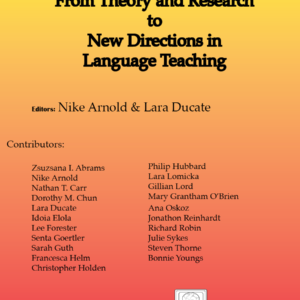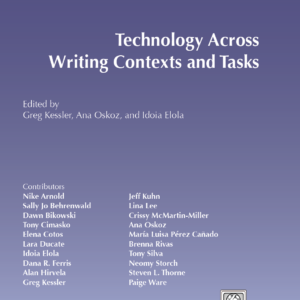The Next Generation
$10.00
Description
The Next Generation
Chapter Information
| Ch. 1 | Lara Lomicka Gillian Lord |
Introduction to social networking, collaboration, and Web 2.0 tools In the introduction to this volume, we provide an overview of Web 2.0–what it is, what tools and applications make up the Web 2.0 world, and where we stand with respect to language teaching and learning. We provide an overview of the chapters that make up the volume and suggest future directions for CALL teachers and researchers interested in expanding the growing body of Web 2.0 research. |
| Ch. 2 | Fernando Rosell-Aguilar | Podcasting for language learning: Re-examining the potential The popularity of portable media players and podcasting has increased in the last few years. Some researchers were quick to identify the potential uses and benefits of podcasting for language learning (Belanger, 2005; Clark & Walsh, 2005; Kaplan-Leiserson, 2005; Manning, 2006; Meng, 2005; Moody, 2006; Scinicariello, 2006; Sloan, 2005; Stanley, 2006; Thorne & Payne, 2005). However, “research into students’ experience of podcasting is in its very early stages” (Edirisingha, Rizzi, Nie, & Rothwell, 2007, p. 88). This chapter presents a review of how podcasting fits with language-learning theories (including constructivist approaches, the use of authentic materials, and informal and lifelong learning, among others), what features were identified as potential benefits of podcasting for language learning and what evidence we have now to support those claims. It focuses on the learning experience of the end users by examining a number of reports into students’ use of podcasting resources. The results show a varied picture of approaches, contexts, uses, and resources as well as some indications that student use in certain contexts is not what was expected. |
| Ch. 3 | Kara McBride | Social-networking sites in foreign language classes: Opportunities for re-creation Social-networking sites (SNSs) are used frequently by especially young people in our society and could potentially be used in foreign language (FL ) classes to practice the FL and FL pragmatics, capture students’ interest, engage students in active and productive projects, fit their communication habits, prepare them for likely future encounters in computer-mediated communication, learn more about other cultures, engage them in identity exploration, and poise them for becoming autonomous learners. There are also a number of pitfalls, however, that could make the implementation of such projects either difficult or unsuccessful. This chapter explores possibilities in using a SNS connected to a FL class by first defining SNSs and then reviewing relevant learning theories that allow us to assess the possible benefits and difficulties of using SNSs with a FL class. In the final section, several examples of current and potential SNS implementation are described. |
| Ch. 4 | Enza Antenos-Conforti | Microblogging on Twitter: Social networking in Intermediate Italian classes This study investigates computer-mediated communication via Twitter, a microblogging service, in an intermediate university level Italian course. Students enrolled in both sections of this course were required to sign up for Twitter and tweet three times a week for 14 weeks. At the end of the semester, students were asked to evaluate their Twitter experience, and frequent twitterers were asked to complete a second questionnaire in which they further reflected on their experience. This study addresses the following research questions: (a) What are students’ “Twitter habits”? that is, With what frequency do students tweet, what factors affect that frequency, and what topics do they initiate? and (b) How do students evaluate Twitter as a pedagogical tool for learning the Italian language and learning about Italian culture? Results show that students engaged in Twitter for many reasons (e.g., community of followers, both classmates and native speakers) and that they perceived the experience as positively affecting their learning of the Italian language and of Italian culture. |
| Ch. 5 | Esperanza Román-Mendoza | RSS and social personalized start pages: Optimizing e-language learning through content syndication As web applications become more prevalent in our daily lives, teachers and students are fortunate to be faced with the challenge of using its contents and services to engage in meaningful learning processes. RSS technologies–particularly social personalized start pages–stand out as among the most powerful tools to retrieve, organize, and remix all types of online information. They provide students with an environment to handle information and produce useful output by collaborating and communicating with each other in a scalable and aggregative way. This chapter analyzes how to implement these tools to create a personal learning environment in which students, through goal-oriented learning, can understand cultural contexts, develop multiple literacies, use different channels for interaction, and discover new social dimensions. An example from the field of heritage language education is used to illustrate the educational potential of RSS technologies. |
| Ch. 6 | Nike Arnold Lara Ducate Claudia Kost |
Collaborative writing in wikis: Insights from culture projects in intermediate German classes This exploratory study intends to shed light on the online collaborative writing and revision processes of foreign language (FL) learners. Specifically, it is based on a comparison of two wiki projects in intermediate German classes in which small groups of students used wikis to research cultural and historical topics related to Brussig’s novel Am kürzeren Ende der Sonnenallee. While the wiki assignment in one class was purposely unstructured, the other was heavily guided by the instructor with regard to page content, due dates for a bibliography, outline, and revised versions and also included instructor and peer feedback. All archived versions of each wiki were analyzed by coding students’ revisions based on an adaptation of Faigley and Witte’s (1981) taxonomy. Research questions addressed the amount, type, and quality of revisions comparing the two groups, as well as learners’ perceptions of the project. Results indicate that both groups engaged in a large number of revisions, mostly concerning content and formal accuracy. While the group with the unstructured approach focused more on meaning-changing revisions, the group with the instructor guided approach concentrated more on formal revisions and also achieved a slightly higher success rate in linguistic accuracy in their revisions. Learners regarded the collaborative-writing projects as a positive experience and valued the feedback they received. |
| Ch. 7 | Lawrence Williams Rémi A. van Compernolle |
The chatbot as a peer/tool for learners of French This study investigates interactions between a chatbot and learners of French at various levels of proficiency (i.e., beginning, intermediate, advanced, and near-native) as well as a native speaker of (European) French. Our analysis is organized as a series of linguistic case studies in order to provide a detailed account of interactional and linguistic variation, with specific focus on orthography, interrogative structures, and the use of second-person address pronouns and the negative particle ne. The data demonstrate that the chatbot’s discourse is a combination of forms and structures typically associated with informal and formal discourse. Although this lack of register-related consistency and homogeneity never emerged as an expressed concern of the participants, it is clear that the discourse of this particular chatbot represents a less-than-ideal communicative model for learners. As a peer/tool for language learners, the chatbot may offer some (or even a great deal of) potential; however, at present, post-interaction tasks based on transcripts appear to hold the most promise for language awareness and development. |
| Ch. 8 | Lisa M. Kuriscak Christopher L. Luke |
Language learner attitudes toward virtual worlds: An investigation of Second Life The CMC environment of Second Life (SL) provides second language (L2) learners with new frameworks within which to practice their L2 and interact with other L2 peers and native speakers (NSs) around the world. The present study describes findings from data collected from 107 intermediate-level, college learners of Spanish who engaged in weekly chats in SL–mostly with peers and some with NSs of Spanish. Data from chat logs and surveys were collected for two semesters, and both inter- and intrasemester analyses were conducted in order to better describe learners’ attitudes toward computers and language learning in general, their attitudes toward SL in particular, and their attitudes toward corrective feedback, along with qualitative analyses examining initial patterns in learners’ pragmatic performance. Results indicate that learners who interacted mainly with NSs (as opposed to with NNS peers) in SL had more positive attitudes toward computers and language learning in general, toward SL, and toward corrective feedback by NSs. Furthermore, when learners choose their own topics of conversation they had more positive attitudes toward computers and language learning. Pedagogical implications and directions for future research are suggested. |
| Ch. 9 | Julie M. Sykes | Learner requests in Spanish: Examining the potential of multiuser virtual environments for L2 pragmatic acquisition Interest in multiuser virtual environments (MUVEs) is steadily increasing in both commercial and educational contexts. While certainly not the only relevant online context to be explored, various features of MUVEs make them especially interesting spaces for the development of second language skills which are often inaccessible in the L2 classroom. One such area of importance is that of Interlanguage pragmatic (ILP) development. This chapter reports on one component of a larger study examining ILP development by learners of Spanish in MUVEs. It examines the effects of the use of a synthetic immersive environment (SIE) (i.e., a MUVE created with specific, educationally related purposes) on learners’ abilities to make requests in Spanish. Utilizing a pre- and posttest design, the pragmalinguistic abilities of 25 learners were analyzed to better understand the effects that use of the SIE had on their ability to make requests. Qualitative interview and observation data were also included in the analysis to gain a more comprehensive picture of the effects of the SIE. While quantitative results demonstrate a relatively low level of improvement from pretest to posttest, qualitative data (i.e., interviews and class presentations) suggest an increase in learners’ pragmatic abilities. |
| Ch. 10 | Moniqua Acosta-Heyman Lara Lomicka Maria Ida Fionda Gillian Lord |
Annotated bibliography This chapter provides more detailed information on references that were provided as key works in the field by the chapter authors. Over 100 entries are provided, including a full bibliographic reference and a summary of the book or article. (Download annotated bibliography [.pdf document]) |
Additional information
| Publication Type | .epub, .mobi, .pdf, Print |
|---|






Reviews
There are no reviews yet.